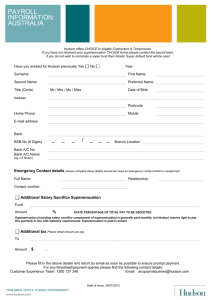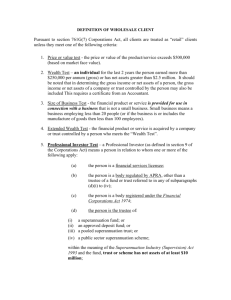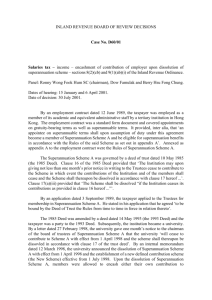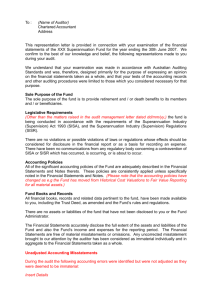INLAND REVENUE BOARD OF REVIEW DECISIONS Case No. D60
advertisement
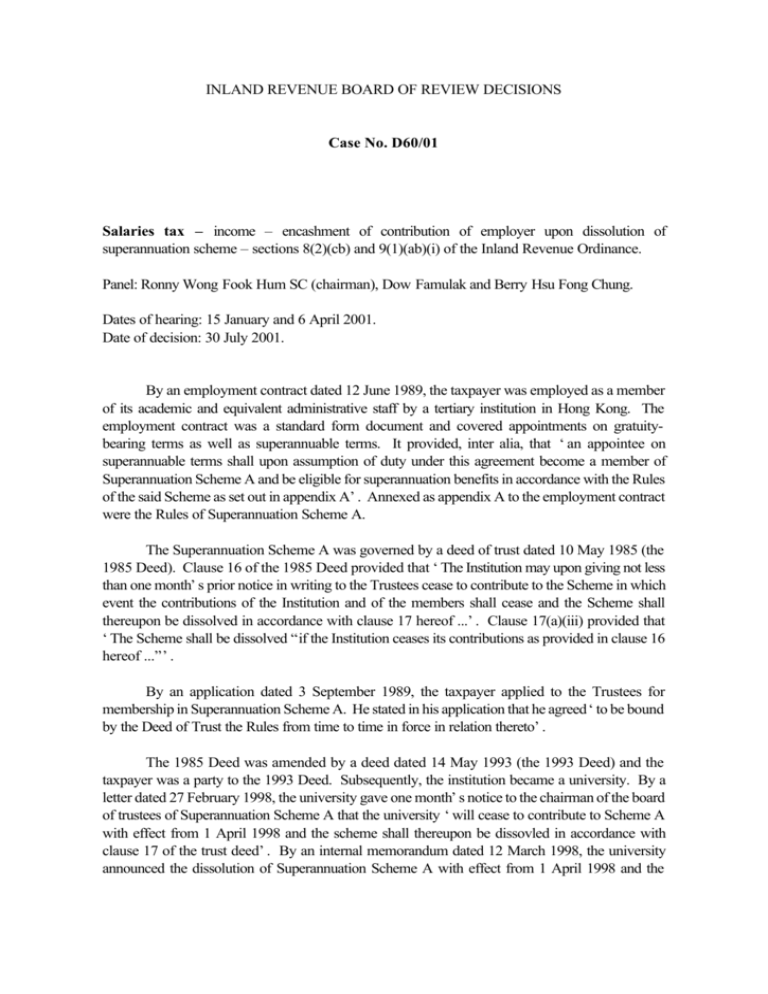
INLAND REVENUE BOARD OF REVIEW DECISIONS Case No. D60/01 Salaries tax – income – encashment of contribution of employer upon dissolution of superannuation scheme – sections 8(2)(cb) and 9(1)(ab)(i) of the Inland Revenue Ordinance. Panel: Ronny Wong Fook Hum SC (chairman), Dow Famulak and Berry Hsu Fong Chung. Dates of hearing: 15 January and 6 April 2001. Date of decision: 30 July 2001. By an employment contract dated 12 June 1989, the taxpayer was employed as a member of its academic and equivalent administrative staff by a tertiary institution in Hong Kong. The employment contract was a standard form document and covered appointments on gratuitybearing terms as well as superannuable terms. It provided, inter alia, that ‘an appointee on superannuable terms shall upon assumption of duty under this agreement become a member of Superannuation Scheme A and be eligible for superannuation benefits in accordance with the Rules of the said Scheme as set out in appendix A’. Annexed as appendix A to the employment contract were the Rules of Superannuation Scheme A. The Superannuation Scheme A was governed by a deed of trust dated 10 May 1985 (the 1985 Deed). Clause 16 of the 1985 Deed provided that ‘The Institution may upon giving not less than one month’s prior notice in writing to the Trustees cease to contribute to the Scheme in which event the contributions of the Institution and of the members shall cease and the Scheme shall thereupon be dissolved in accordance with clause 17 hereof ...’. Clause 17(a)(iii) provided that ‘The Scheme shall be dissolved “if the Institution ceases its contributions as provided in clause 16 hereof ...”’. By an application dated 3 September 1989, the taxpayer applied to the Trustees for membership in Superannuation Scheme A. He stated in his application that he agreed ‘to be bound by the Deed of Trust the Rules from time to time in force in relation thereto’. The 1985 Deed was amended by a deed dated 14 May 1993 (the 1993 Deed) and the taxpayer was a party to the 1993 Deed. Subsequently, the institution became a university. By a letter dated 27 February 1998, the university gave one month’s notice to the chairman of the board of trustees of Superannuation Scheme A that the university ‘will cease to contribute to Scheme A with effect from 1 April 1998 and the scheme shall thereupon be dissovled in accordance with clause 17 of the trust deed’. By an internal memorandum dated 12 March 1998, the university announced the dissolution of Superannuation Scheme A with effect from 1 April 1998 and the INLAND REVENUE BOARD OF REVIEW DECISIONS establishment of a new defined contribution scheme (the New Scheme) effective from 1 July 1998. Upon the dissolution of Superannuation Scheme A, members were allowed to encash either their own contribution to Superannuation Scheme A, their own contribution plus investment earnings or all their vested benefits less an amount equal to the long service payment accrued by the members on the dissolution date. On 15 April 1998, the taxpayer elected to join the New Scheme on 1 July 1998 and to encash all his vested benefits under Superannuation Scheme A less a retained amount equivalent to his accrued long service payment up to 31 March 1998 and to have such retained amount transferred to the New Scheme. The issue before the Board related to the taxability or otherwise of the sum being the university’s contribution to Superannuation Scheme A less the long service payment accrued to the taxpayer in respect of his employment with the university. Held: A majority of the Board was of the view that reasonable notice of the 1985 Deed was given by the university to the taxpayer. The Rules of Superannuation Scheme A annexed as appendix A to the employment contract contain various references to the 1985 Deed. The taxpayer’s attention was expressly drawn to ‘the trust deed setting up the Scheme’ which was available for inspection. A majority of the Board rejected the taxpayer’s contention that clauses 16 and 17(a)(iii) of the 1985 Deed did not form part of his contract of employment with the university. In these circumstances, there was no question of any breach on the part of the university when it terminated Superannuation Scheme A. The sum in question could not be regarded as damages or compensation for breach. The sum fell squarely within the tax net. Appeal dismissed. Cases referred to: Southern Foundries (1926) Ltd v Shirlaw [1940] AC 701 Shindler v Northern Raincoat Co Ltd [1960] 1 WLR 1038 INLAND REVENUE BOARD OF REVIEW DECISIONS D43/98, IRBRD, vol 13,285 Leung Wing Chi for the Commissioner of Inland Revenue. Taxpayer in person. Decision: Background 1. By a deed of trust dated 10 May 1985 (‘the 1985 Deed’) and made between a tertiary institution in Hong Kong (‘the Institution’) and five named trustees (‘the Trustees’), the Institution established a superannuation scheme (‘Superannuation Scheme A’) for its general grade and academic and equivalent administrative grade employees. The 1985 Deed provides as follows: 2. (a) Clause 8: The Institution covenants with the Trustees to pay to the Trustees all sums of money due to be paid by the Institution in accordance with the 1985 Deed and the rules annexed thereto (‘the Rules’). (b) Clause 9: The trust fund shall consist of the contributions of the Institution and the contributions of the general grade staff members and of the academic and equivalent administrative staff members. (c) Clause 15: The Institution may alter or delete any of the provisions of the 1985 Deed or the Rules but no such alteration or deletion shall affect adversely benefits already secured or due to a member. (d) Clause 16: ‘The Institution may upon giving not less than one month’s prior notice in writing to the Trustees cease to contribute to the Scheme in which event the contributions of the Institution and of the members shall cease and the Scheme shall thereupon be dissolved in accordance with clause 17 hereof or at the discretion of the Institution be continued as a closed fund for the benefit of the members at the date of cessation of contributions.’ (e) Clause 17(a)(iii): The Scheme shall be dissolved ‘if the Institution ceases its contributions as provided in clause 16 hereof and the Institution does not decide to continue the Scheme as a closed fund.’ The Rules provide as follows: INLAND REVENUE BOARD OF REVIEW DECISIONS 3. (a) Rule 2: All employees of academic and equivalent administrative staff grade shall be required to become academic and equivalent administrative staff members of the Scheme at the date of appointment on superannuable terms of employment. (b) Rule 3(a): The Institution shall deduct from the salary of each member at the time it is paid to the member a sum equal to 5% of the members’ scheme salary and shall forthwith pay the sum so deducted to the Trustees as the member’s contribution to the Scheme. (c) Rule 3(b): At the same time as the member’s contributions are paid to the Trustees, the Institution shall pay to the Trustees in respect of each member a sum equal to 15% of the member’s scheme salary. (d) Rule 5: The Trustees shall pay from the trust fund specified benefits to each member upon his retirement or death or upon the termination of his employment with the Institution. (e) Rule 17: Nothing in these Rules shall constitute a contract of employment or give an employee the right to be retained in the employ of the Institution. Various amendments were made to the 1985 Deed and to the Rules. 4. By an agreement dated 12 June 1989 (‘the Employment Contract’) between the Institution and the Taxpayer, the Taxpayer was employed by the Institution as a member of its academic and equivalent administrative staff. The Employment Contract is a standard form document and covers appointments on gratuity-bearing terms as well as superannuable terms. It provides: (a) By clause F1.2 that ‘An appointee on superannuable terms shall upon assumption of duty under this agreement become a member of Superannuation Scheme A [of the Institution] and be eligible for superannuation benefits in accordance with the Rules of the said Scheme as set out in appendix A’. (b) By clause J1 that ‘Notwithstanding anything contained in this agreement or in the accompanying letter of appointment [the Institution] reserves the right to alter any of the appointee’s terms of appointment and/or conditions of employment set out in this agreement or the said letter provided always that no such alteration shall be made which would retrospectively lower salary or allowances, or reduce accrued benefits relating to service prior to the implementation of such alterations. All alterations shall be notified to the appointee in writing by the general secretary.’ INLAND REVENUE BOARD OF REVIEW DECISIONS 5. Annexed as appendix A to the Employment Contract are the Rules of Superannuation Scheme A. The following statement can be found at the end of the appendix: ‘THE CLAUSES MENTIONED IN THESE RULES REFER TO THE TRUST DEED SETTING UP THE SCHEME WHICH IS AVAILABLE FOR INSPECTION IN THE GENERAL SECRETARY’S OFFICE’. 6. The Taxpayer was engaged by the Institution on superannuable terms. By an application dated 3 September 1989, the Taxpayer applied to the Trustees for membership in Superannuation Scheme A. He stated in his application that he agreed ‘to be bound by the Deed of Trust the Rules from time to time in force in relation thereto’. 7. The 1985 Deed was amended by a deed dated 14 May 1993 (‘the 1993 Deed’). The Taxpayer was a party to the 1993 Deed. He had by that stage become one of the trustees of Superannuation Scheme A. 8. In about October 1997, the Institution, which had by then become a university in Hong Kong (‘the University’), commissioned a report by a consulting firm, Company B, on the proposed restructuring of Superannuation Scheme A. The University was concerned with the potential funding risk posed to itself by the Occupational Retirement Schemes Ordinance which established a demanding solvency standard for defined-benefit scheme sponsors. Company B proposed three options in their report dated 9 October 1997. These proposals were strongly opposed by members of the University including the Taxpayer. Their opposition was of no avail. 9. By letter dated 27 February 1998, the University gave one month’s notice to the chairman of the board of trustees of Superannuation Scheme A that the University ‘will cease to contribute to Scheme A with effect from 1 April 1998 and the scheme shall thereupon be dissolved in accordance with clause 17 of the trust deed.’ 10. By an internal memorandum dated 12 March 1998 (‘the Memo’), the University announced the dissolution of Superannuation Scheme A with effect from 1 April 1998 and the establishment of a new defined contribution scheme (‘the New Scheme’) in place of Superannuation Scheme A with effect from 1 July 1998. The Memo detailed the options available to members with respect to their future service after 31 March 1998. Members may elect to join and become a member of the New Scheme on 1 July 1998 or to receive an annual gratuity (payable in arrears) of 15% of basic salary with effect from 1 July 1998. Upon dissolution of Superannuation Scheme A, members were allowed to encash either their own contribution to Superannuation Scheme A, their own contribution plus investment earnings or all their vested benefits less an amount equal to the long service payment accrued by the members on the dissolution date, that is, 31 March 1998. INLAND REVENUE BOARD OF REVIEW DECISIONS 11. On 15 April 1998, the taxpayer elected to join the New Scheme on 1 July 1998 and to encash all his vested benefits under Superannuation Scheme A less a retained amount equivalent to his accrued long service payment up to 31 March 1998 and to have such retained amount transferred to the New Scheme. 12. Vested benefits of the Taxpayer upon dissolution of Superannuation Scheme A on 31 March 1998 were calculated by reference to the following leaving service benefit formula: Final salary Vesting multiple Year of service as at 31 March 1998 x (based on scheme service) x (on completed month basis) $72,135 x 2.2 x 8 7/12 =$1,362,149 13. The vested benefits of the Taxpayer under Superannuation Scheme A as at 31 March 1998 were made up of the following: The Taxpayer’s contributing The University’s contribution Investment earnings $ 267,989 803,968 290,192 1,362,149 14. As at 31 March 1998, long service payment accrued to the Taxpayer in respect of his employment with the University amounted to $128,753. Out of the University’s contribution of $803,968 to Superannuation Scheme A, this amount of $128,753 was retained and transferred to the New Scheme. The Taxpayer encashed the balance of the University’s contribution amounting to $675,214. The issue before us relates to the taxability or otherwise of this sum of $675,214. The case of the Taxpayer 15. The dissolution of Superannuation Scheme A was a breach of his contract of employment. ‘The benefits paid to me were part compensation/damages for breach of contract. By dissolving [Superannuation Scheme A], I have lost the benefits I was looking forward to at retirement. [Superannuation Scheme A] was a defined benefits scheme. The new superannuation scheme started by the University is a defined contributions scheme.’ 16. ‘The assessor has argued that the University had the right to unilaterally terminate [Superannuation Scheme A]. The University did not have the right to terminate.’ INLAND REVENUE BOARD OF REVIEW DECISIONS 17. The Taxpayer asserted that there was no need for him to inspect the trust deed setting up the scheme. He emphasised that the trust deed was not attached to his letter of appointment. He placed reliance on Southern Foundries (1926) Ltd v Shirlaw [1940] AC 701 and Shindler v Northern Raincoat Co Ltd [1960] 1 WLR 1038. The determination of the Commissioner and the case of the Respondent 18. The Commissioner took the view that: ‘ The sum in dispute was the University’s contribution to the Scheme encashed by [the Taxpayer] upon dissolution of the Scheme. The sum was withdrawn from a recognized occupational retirement scheme. The law is clear that a sum represents the employer’s contributions withdrawn from a recognized occupational retirement scheme by reason other than termination of service, death, incapacity or retirement is assessable to tax. The sum was paid to [the Taxpayer] upon dissolution of the Scheme without any termination of his employment with the University and [the Taxpayer] had not yet reached the retirement age at the time of payment. Such being the case, the sum falls squarely under section 9(1)(ab)(i) to be taxable and the exemption provided under section 8(2)(cb) of the Ordinance is not applicable.’ 19. The Commissioner is of the further view that the present case is distinguishable from the decision of this Board in D43/98, IRBRD, vol 13, 285. The University is entitled to terminate Superannuation Scheme A without the consent of its members. There is therefore no breach on the part of the University which calls for compensation to the Taxpayer. Our decision 20. The Taxpayer maintains that clause 17(a)(iii) is not part of his contract of employment. The 1985 Deed was not annexed to the Employment Contract and he had no notice of the relevant clause. 21. The law is stated in paragraph 12-013 and paragraph 12-014 of Chitty (above cited): ‘ Meaning of notice. It is not necessary that the conditions contained in the standard form document should have been read by the person receiving it, or that he should have been made subjectively aware of their import or effect. The rules which have been laid down by the courts regarding notice in such circumstances are three in number: (1) If the person receiving the document did not know that there was writing or printing on it, he is not bound. INLAND REVENUE BOARD OF REVIEW DECISIONS (2) If he knew that the writing or printing contained or referred to conditions, he is bound. (3) If the party tendering the document did what was reasonably sufficient to give the other party notice of the conditions, and if the other party knew that there was writing or printing on the document, but did not know it contained conditions, then the conditions will become the terms of the contract between them.’ ‘ Reasonable sufficiency of notice. ... The question whether the party tendering the document has done all that was reasonably sufficient to give the other notice of the conditions is a question of fact in each case, in answering which the tribunal must look at all the circumstances and the situation of the parties ... It is not necessary that the conditions themselves should be set out in the document tendered: they may be incorporated by reference, provided that reasonable notice of them has been given.’ 22. A majority of us is of the view that reasonable notice of the 1985 Deed was given by the University to the Taxpayer. The Rules of Superannuation Scheme A annexed as appendix A to the Employment Contract contain various references to the Deed. The Taxpayer’s attention was expressly drawn to ‘the trust deed setting up the Scheme’ which is available for inspection. A majority of us rejects the Taxpayer’s contention that clauses 16 and 17(a)(iii) of the 1985 Deed do not form part of his contract of employment with the University. In these circumstances, there is no question of any breach on the part of the University when it terminated Superannuation Scheme A. The sum in question could not be regarded as damages or compensation for breach. The sum falls squarely within the tax net as explained in the determination of the Commissioner. 23. A minority of this Board is however of the view that the provisions of the 1985 Deed did not form part of the Taxpayer’s contract of employment As pointed out in paragraph 4(a) above, his Employment Contract expressly provided that he was eligible for superannuation benefit in accordance with the Rules of the Scheme as set out in appendix A to that contract. Those terms alone regulate the relationship between the parties and the University has no right to terminate the scheme. 24. Given the views of the majority, we dismiss the appeal and confirm the assessment.

